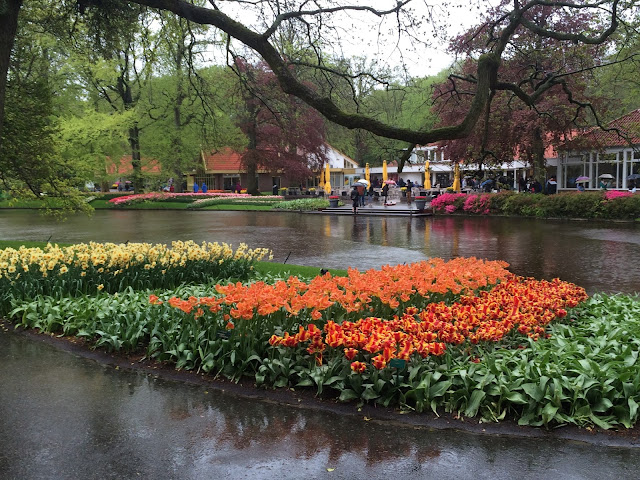Two connecting buses, about an hour ride total from Amsterdam, got me to Keukenhof. (You can also take the train.) I visited in early May when there was still plenty in bloom and took these pictures with my cell phone, as I had filled the card on my camera and forgotten to bring an extra one.
This planting combination included single and double hybrids and species tulips, muscari, and anemone. As one of the gardeners I spoke to told me, they can get about 9 weeks of bloom out of some of the mixed plantings, which are so dense you need to get close to notice everything that is there.
It's not just the bulbs, but the "window dressing" is pretty spectacular as well. I love the geometry of these clipped trees and hedges, which set off displays of older varieties and species bulbs in this section.
 |
| An allee of Chestnut trees |
A couple favorite old bulb varieties: Tulipa saxatilis, which produced the cultivar 'Lilac Wonder.' The straight species is native to Crete and western Turkey. Below it is Narcissus triandrus, native to France, Spain and Portugal, a dainty daffodil producing multiple flowers on a single stem and commonly known as Angel's Tears because of the drooping flowers. 'Thalia' is commonly known cultivar.
A staute of 16th century botanist Carolus Clusius (aka Charles de l'Ecluse) sits in the historic section of Keukenhof. He established one of the earliest botanical gardens in Leyden and is credited with laying the foundation for the Dutch bulb trade. (More about him here.) Tulipa clusiana 'Cynthia' is cultivar worth trying.
At the edge of Kuekenhof is a classic Dutch view of the surrounding bulb fields -- here a swath of tomato-red--and the very flat, open terrain.
This was an amusing bit of fakery. Don the hat, pick up the brush and palette, dab at the canvas provided and you can appear to be an artiste en plein air! Pretty convincing, eh?
 |
| A variety of containers |
Not my favorite color combination, but I appreciate the variety of plants -- Euphorbia (polychroma?), Heuchera, Geranium 'Samabor', and Alchemila mollis.
 |
| Accompanying succulents! |
 |
| And here too. |
 |
| Building the Lily display |
 |
| Our native Cypripedium was represented in the Orchid display |
 |
| Those dark figures are women in burqas |
A rain storm didn't keep this intrepid gardener from his work slicing off stems of spent flowers to keep things tidy. Two gardeners (both men) told me that 50 gardeners plant all the bulbs starting the first of October and finishing by the end of December. It is now done by machine, but not that long ago was done by hand. Both of them have been at Keukenhof for about 20 years. Once finished, all the bulbs are ripped out and discarded.
The effects of botrytis, a common tulip fungus, is why hybrid tulip plantings in many public spaces and gardens are dug up and thrown out after blooming. (It is done here in the Washington, DC.) The fungus is difficult to control and prevents many of the hybrids from re-blooming reliably from year to year. For regular bloom, the smaller species tulips are a better choice, though, as Keukenhof demonstrates, you can't beat the showiness of a hybrid tulips.















Timely post, as I am working on my bulb order at work for plant out this fall. I have seen photos of Keukenhof's elaborate beds, and yes they are spectacular in bloom, but I have always wondered what they look like when the bulbs are gone. If they lay fallow until next spring, it seems like a waste of good garden space.
ReplyDeleteLes,
ReplyDeleteI hope you find some inspiration for your bulb order. As you may know, Keukenhof is open for only 2 months, which is sort of astonishing. Not sure what happens there during the off season, although I think I read that the "castle" (I didn't see any castle, however) is used for festivals so maybe it gets used for special events.
sarah
It has a bit of a Willy Wonkaesque feel to it. I kept waiting for the river of chocolate. I like the first picture best. The mixed plantings are the most interesting to me.
ReplyDeleteHi Sarah, looks like you are having a good time. I too generally prefer the smaller species tulips that stick around for a while. I have Praestans fusilliers that have returned for almost 40 years.
ReplyDelete